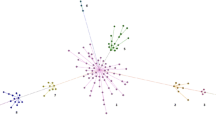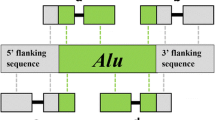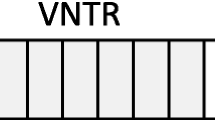Summary
A comparison of Alu sequences that comprise more recently amplified Alu subfamilies was made. There are 18 individual diagnostic mutations associated with the different subfamilies. This analysis confirmed that the formation of each subfamily can be explained by the sequential accumulation of mutations relative to the previous subfamily. Polymerase chain reaction amplification of orthologous loci in several primate species allowed us to determine the time of insertion of Alu sequences in individual loci. These data suggest that the vast majority of Alu elements amplified at any given time comprised a single Alu subfamily. We find that, although the individual divergence relative to a consensus sequence correlate reasonably well with sequence age, the diagnostic mutations are a more accurate measure of the age of any individual Alu family member. Our data are consistent with a model in which all Alu family members have been made from a single master gene or from a series of sequential master genes. This master gene(s) accumulated diagnostic base changes, resulting in the amplification of different subfamilies from the master gene at different times in primate evolution. The changes in the master gene(s) probably occurred individually, but their appearance is clearly punctuated. Ten of them have occurred within an ∼15-million-year time span, 40–25 million years ago, and 8 changes have occurred within the last 5 million years. Surprisingly, no changes appeared in the 20 milion years separating these periods.
Similar content being viewed by others
References
Ausabel FM, Brent R, Kingston RE, Moore DD, Seidman JG, Smith JA, Struhl K (eds) (1987) Current protocols in molecular biology. John Wiley and Sons, New York
Batzer MA, Deininger PL (1991) A human-specific subfamily of Alu sequences. Genomics 9:481–487
Batzer MA, Kilroy GE, Richard PE, Shaikh TH, Desselle TD, Hoppens CL, Deininger PL (1990) Structure and variability of recently inserted Alu family members. Nucleic Acids Res 18:6793–6798
Bird AP (1980) DNA methylation and the frequency of CpG in animal DNA. Nucleic Acids Res 8:1499–1504
Britten RJ, Baron WF, Stout DB, Davidson EH (1988) Sources and evolution of human Alu repeated sequences. Proc Natl Acad Sci USA 85:4770–4774
Britten RJ, Stout DB, Davidson EH (1989) The current source of human Alu retroposons is a conserved gene shared with Old World monkey. Proc Natl Acad Sci USA 86:3718–3722
Coulondre C, Miller JH, Farabaugh PJ, Gilbert W (1978) Molecular basis of base substitution hotspots inEscherichia coli. Nature 274:775–780
Daniels GR, Fox GM, Loewensteiner D, Schmid CW, Deininger PL (1983) Species-specific homogeneity of the primate Alu family of repeated DNA sequences. Nucleic Acids Res 11:7579–7593
Deininger PL (1989) SINEs: short interspersed repeated DNA elements in higher eucaryotes. In: Berg DE and Howe MM (eds) Mobile DNA. American Society for Microbiology, Washington DC, pp 619–636
Deininger PL, Daniels GR (1986) The recent evolution of mammalian repetitive DNA elements. Trends Genet 2:76–80
Deininger PL, Slagel VK (1988) Recently amplified Alu family members share a common parental Alu sequence. Mol Cell Biol 8:4566–4569
Economou EP, Bergen AW, Warren AC, Antonarakis SE (1990) The polydeoxyadenylate tract of Alu repetitive elements is polymorphic in the human genome. Proc Natl Acad Sci USA 87:2951–2954
Epstein N, Nahor O, Silver J (1990) The 3′ ends of Alu repeats are highly polymorphic. Nucleic Acids Res 18:4634
Freizner-Degen SJ, Rajput B, Reich E (1986) The human tissue plasminogen activator gene. J Biol Chem 261:6972–6985
Houck CM, Rinehart FP, Schmid CW (1979) Ubiquitous family of repeated DNA sequences in the human genome. J Mol Biol 132:289–306
Jagadeeswaran P, Forget BG, Weissman SM (1981) Short, interspersed repetitive DNA elements in eukaryotes: transposable DNA elements generated by reverse transcription of RNA pol III transcripts? Cell 26:141–142
Jelinek WR, Toomey TP, Leinwand L, Duncan CH, Biro PA, Choudary PV, Weissman SM, Rubin CM, Houck CM, Deininger PL, Schmid CW (1980) Ubiquitous interspersed repeated sequences in mammalian genomes. Proc Natl Acad Sci USA 77:1398–1402
Jurka J, Milosavljevic A (1991) Reconstruction and analysis of human Alu genes. J Mol Evol 32:105–121
Jurka J, Smith T (1988) A fundamental division in the Alu family of repeated sequences. Proc Natl Acad Sci USA 85:4775–4778
Koop BF, Miyamoto MM, Embury JE, Goodman M, Czelusniak J, Slightom JL (1986) Nucleotide sequence and evolution of the orangutan ε-globin gene region and surrounding Alu repeats. J Mol Evol 24:94–102
Labuda D, Striker G (1989) Sequence conservation in Alu evolution. Nucleic Acids Res 17:2477–2491
Lipman DJ, Pearson WR (1985) Rapid and sensitive protein similarity searches. Science 227:1435–1441
Matera GA, Hellmann U, Schmid CW (1990a) A transpositionally and transcriptionally competent Alu subfamily. Mol Cell Biol 10:5424–5432
Matera GA, Hellmann U, Hintz MF, Schmid CW (1990b) Recently transposed Alu repeats result from multiple source genes. Nucleic Acids Res 18:6019–6023
Matera GA, Weiner AM, Schmid CW (1990c) Structure and evolution of the U2 small nuclear RNA multigene family in primates: gene amplification under natural selection? Mol Cell Biol 10:5876–5882
Miyamoto MM, Slightom JL, Goodman M (1987) Phylogenetic relations of humans and African apes from DNA sequences in the pseudo-η-globin region. Science 238:369–373
Rinehart FP, Ritch TG, Deininger PL, Schmid CW (1981) Renaturation rate studies of a single family of interspersed repeated DNA sequences in human deoxyribonucleic acid. Biochemistry 20:3003–3010
Ryan SC, Dugaiczyk A (1989) Newly arisen DNA repeats in primate phylogeny. Proc Natl Acad Sci USA 86:9360–9364
Sawada I, Schmid CW (1986) Primate evolution of the α-globin gene cluster and its Alu-like repeats. J Mol Biol 192:693–709
Sawada I, Willard C, Shen C-KJ, Chapman B, Wilson AC, Schmid CW (1985) Evolution of the Alu family repeats since the divergence of human and chimpanzee. J Mol Evol 22:316–322
Slagel V, Flemington E, Traina-Dorge V, Bradshaw H Jr, Deininger PL (1987) Clustering and sub-family relationships of the Alu family in the human genome. Mol Biol Evol 4:19–29
Stoppa-Lyonnet D, Carter PE, Meo T, Tosi M (1990) Clusters of intragenic Alu repeats predispose the human Cl inhibitor locus to deleterious rearrangements. Proc Natl Acad Sci USA 87:1551–1555
Trabuchet G, Chebloume Y, Savatier P, Lachuer J, Faure C, Verdier G, Nigon VM (1987) Recent insertion of an Alu sequence in the beta-globin gene cluster of the gorilla. J Mol Evol 25:288–291
Willard C, Nguyen HT, Schmid CW (1987) Existence of at least three distinct Alu subfamilies. J Mol Biol 26:180–186
Author information
Authors and Affiliations
Rights and permissions
About this article
Cite this article
Richard Shen, M., Batzer, M.A. & Deininger, P.L. Evolution of the master Alu gene(s). J Mol Evol 33, 311–320 (1991). https://doi.org/10.1007/BF02102862
Received:
Revised:
Issue Date:
DOI: https://doi.org/10.1007/BF02102862




